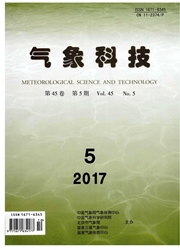

 中文摘要:
中文摘要:
针对FY3A/VIRR海面温度(SST)业务产品温度偏低的现状,进行误差原因分析,并对SST产品算法进行了如下改进:采用精度优先原则,以尽可能大的SST覆盖度提高SST反演精度;针对业务SST云污染的现状,构建3×3数据块,并在此基础上进行了SST空间一致性检验;引入气候阈值检验,以进一步剔除异常值。改进后的SST产品,全球日平均SST的覆盖度有所降低,但SST的一致性提高了;算法改进前后全球月平均SST覆盖度基本一致,但改进后云污染的现象得到了抑制。利用分析场日平均OISST对改进后的FY3ASST进行了质量检验,在南北纬70°之间的海域,FY3ASST的全局精度为-0.23±1.74℃,负的偏差说明云和气溶胶的影响仍然存在。改进后的FY3ASST 1.74℃的均方根误差与FY3A VIRR 11μm通道1.6K的定标精度量级相当。
 英文摘要:
英文摘要:
FY3A/VIRR SST (Sea Surface Temperature) is cooler than other reference SST, mainly because the radiation emitted from ocean has to go through a longer atmospheric path before reaching the VIRR instrument at higher zenith angles. Only when the satellite zenith angles less than 50°, is SST evaluated. The disadvantage of limiting zenith angle leads to the loss in geographic coverage. The brightness temperatures for channels 10.8 gm and 12 μm are examined for all pixels within a 3 × 3 pixel box centered on the pixel being spatial uniformity tested, and the cloud contaminated pixels are identified. The climate threshold test is also introduced to further eliminate the outliers. After the improvement of FY3A/VIRR SST algorithm, the global coverage of daily SST is decreased, but the consistency of SST is increased, and cloud contamination phenomena are suppressed, especially for monthly SST. Comparison with the global grid daily OISST within 70°N to 70°S of latitude, the global accuracy of FY3A/VIRR SST is --0.23 ℃ ±1.74 ℃. The negative bias shows that the effect of clouds and aerosols still exists. RMS of the improved FY3A/VIRR SST is 1.74 ℃, which quite agrees with the calibration accuracy (1.6 K) of the FY3A VIRR 11 μm channel.
 同期刊论文项目
同期刊论文项目
 同项目期刊论文
同项目期刊论文
 Regression modeling of finite field and anti-electromagnetic design for the ocean surface wind speed
Regression modeling of finite field and anti-electromagnetic design for the ocean surface wind speed 期刊信息
期刊信息
